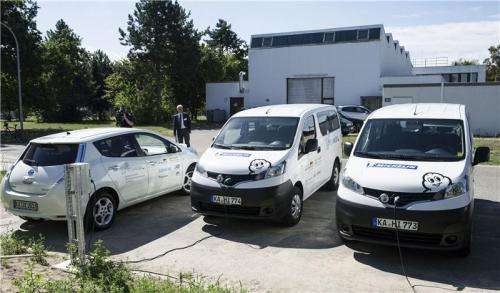Mix of quick and conventional charging protects the battery

Interference-free charging is a major prerequisite for the economically efficient use of electric vehicles. After about 120,000 km driven electrically, the RheinMobil project has proved that a combination of quick and conventional charging is ideal for the battery performance: The controlled mix ensures a high utilization rate of the vehicles and protects the battery. RheinMobil is a joint project of Michelin, Siemens, Karlsruhe Institute of Technology (KIT), the Fraunhofer Institute for Systems and Innovation Research ISI, and the mobility services company e-Motion Line (eML). The project is part of the "LivingLab BWe mobil" electric mobility showcase funded by the Federal Republic of Germany.
RheinMobil is aimed at demonstrating that certain utilization profiles allow for an economically efficient operation of electric vehicles, with commuting and business traffic between Karlsruhe and the Alsace region being used as an example. Presently, six minibuses with seven seats each are commuting daily for Michelin, while Siemens operates a compact vehicle for business trips. Every monthly, each vehicle drives an average of about 3000 km. "Since the start of the project last spring, we have found that conventional vehicles can be replaced by electric vehicles for both operation profiles. On the local level, we have already reduced CO2 emissions by eight tons," Dr. Olaf Wollersheim, one of the two RheinMobil Project Heads at KIT, says. "Moreover, we realized in the winter months that weather and temperature fluctuations caused the energy consumption to increase, while the operability and availability of the vehicles were not affected," Dr. Kevin Stella, who coordinates the project together with Wollersheim, adds.
In the next step, utilization rate of the vehicles by Michelin is planned to be increased with several groups of commuters using every vehicle in accordance with the shift plan. In this way, the milage will rise to several hundred kilometers per day. However, this will require quick charging that presently takes about 30 minutes, whereas conventional charging requires stop times of nine hours. The RheinMobil team wishes to show that electric vehicles are technically reliable also in case of frequent quick charging and that they are economically more efficient than comparable vehicles with a combustion engine in the long term. So far, the influence of quick charging on the battery performance has hardly been studied. Only little scientific knowledge from real operation is available. "The first 100,000 km yielded an important result: Although quick charging is the prerequisite for a high utilization rate, we cannot entirely focus on this technology. The right approach is to use the controlled mix of both quick and conventional charging. In this way, a high vehicle availability can be brought in line with the sustainable use of this technology," Stella says.
Commuter traffic demonstrated that in case of quick charging exclusively, no voltage balancing took place between the battery cells (passive balancing): The cells of the battery were charged and discharged to a variable extent, which would have reduced the usable capacity of the battery in the long term. The solution: In case of longer stop times of the vehicle – e.g. over the night –, RheinMobil will charge them conventionally. "In this case, it is possible to cool or heat the vehicle with a battery-driven air conditioning system prior to the drive in the summer or winter. Energy consumption during the drive can be reduced, as the energy required is not taken from the battery," Kevin Stella says. This makes vehicle operation more comfortable for the users.
Direct Charging after the Drive in Winter – Tips for Users
The scientific studies and experience gained by the project partners, KIT, ISI, and the mobility service company eML, allow further concrete tips to be derived for drivers. Among others, electric vehicles should be charged directly after a drive in winter. "If the battery temperature is too low, the charging power is reduced to protect the battery. Hence, charging would take much longer," Stella explains. The scientists analyze the specific energy consumption per trip and determine the factors influencing it. On this basis, the users can be given concrete tips with respect to their driving behavior and energy consumption is reduced.
Provided by Karlsruhe Institute of Technology




















